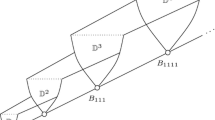Abstract
A foundational algebra (\(\mathfrak{B}\), f, λ) consists of a hemimorphism f on a Boolean algebra\(\mathfrak{B}\) with a greatest solution λ to the condition α⩽f(x). The quasi-variety of foundational algebras has a decidable equational theory, and generates the same variety as the complex algebras of structures (X, R), where f is given by R-images and λ is the non-wellfounded part of binary relation R.
The corresponding results hold for algebras satisfying λ=0, with respect to complex algebras of wellfounded binary relations. These algebras, however, generate the variety of all (\(\mathfrak{B}\),f) with f a hemimorphism on \(\mathfrak{B}\)).
Admitting a second hemimorphism corresponding to the transitive closure of R allows foundational algebras to be equationally defined, in a way that gives a refined analysis of the notion of diagonalisable algebra.
Similar content being viewed by others
References
Claudio Bernardi, On the equational class of diagonalisable algebras, Studia Logica 34 (1975), pp. 322–331.
George Boolos, The Unprovability of Consistency, Cambridge University Press, 1979.
George Grätzer, Universal Algebra, van Nostrand, 1968.
Paul Halmos, Algebraic logic I. Monadic Boolean algebras, Compositio Mathematica 12 (1955), pp. 217–249.
David Harel, First-Order Dynamic Logic, Lecture Notes in Computer Science 68, Springer-Verlag, 1979.
G. E. Hughes and M. J. Cresswell, An Introduction to Modal Logic, Methuen, 1968.
Bjarni Jónsson and Alfred Tarski, Boolean algebras with operators; Part I, American Journal of Mathematics 73 (1951), pp. 891–939, and Part II, American Journal of Mathematics 74 (1952), pp. 127–162.
E. J. Lemmon, Algebraic semantics of modal logics I, Journal of Symbolic Logic 31 (1966), pp. 46–65.
E. J. Lemmon, Algebraic semantics of modal logics II, Journal of Symbolic Logic 31 (1966), pp. 191–218.
Roberto Magari, Representation and duality theory for diagonalisable algebras, Studia Logica 34 (1975), pp. 305–313.
Krister Segerberg, An Essay in Classical Modal Logic, Uppsala: The Philosophical Society and the Department of Philosophy, University of Uppsala, 1971.
Krister Segerberg, A completeness theorem in the modal logic of programs, in Universal Algebra and Applications, T. Traczyk (ed.) Banach Centre Publications, vol. 9, PWN — Polish Scientific Publishers, Warsaw 1982.
Author information
Authors and Affiliations
Additional information
The research reported in this paper was carried out while the author was at the Department of Mathematics and Statistics, University of Auckland, under a teaching exchange with the Victoria University of Wellington.
Rights and permissions
About this article
Cite this article
Goldblatt, R. An algebraic study of well-foundedness. Stud Logica 44, 423–437 (1985). https://doi.org/10.1007/BF00370431
Received:
Issue Date:
DOI: https://doi.org/10.1007/BF00370431




